REVOLUTION AND RESISTANCE IN THE 20TH CENTURY
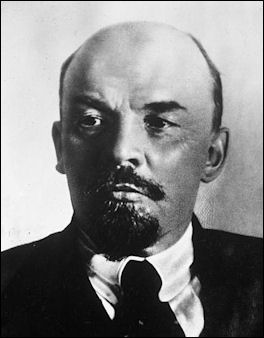
Lenin Algerians militants, Palestinian fighters, the Italian Red Brigades, the German Red Army Faction, the Basque ETA, Colombian FARC, the Shining Path of Peru and the Tamil Tigers of Sri Lanka are among the 20th century groups that have been labeled as terrorist. The political activism and guerrilla tactics favored by Russian Bolsheviks, the Maoist insurgents, French Resistance and African National Congress were different.
Book: Blood and Rage: A Cultural History of Terrorism by Michael Burleigh (Harper/HarperCollins Publishers, 2009)
LENIN
Nikolai Lenin (1870-1924) was one of the most influential people in the 20th century. The leader of the Bolshevik Revolution, he transformed Communism from a political theory into a principal for running a nation and created one of the world's largest empires, the Soviet Union. Historian John Keegan declared that Lenin should be Time Magazine's the Man of the Century. "The ideas of Karl Marx were of little more than philosophical important until 1917," Keegan wrote, "when Lenin applied those ideas with revolutionary force" and "Russia became a example to Marxist revolutionaries everywhere and energized nationalist reactionaries, of whom the most important was Adolf Hitler." Based on the number of books written about him (4,007 in 1999 in the Library of Congress collection), Vladamir Lenin is the world's third most famous person. He ranks behind Jesus and Shakespeare but ahead of Hitler and Buddha.
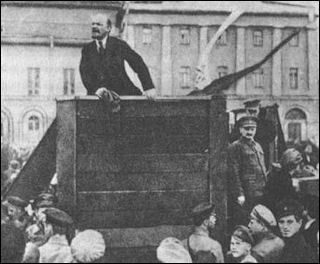
Lenin in Red Square As the leader of the Bolsheviks, Lenin was regarded as uncompromising, radical. He established a terrorist organization that infiltrated tsarist organizations and clamped on freedom of expression in an effort to keep party members disciplined and committed. After the unsuccessful 1905 Revolution Lenin called for workers to take up arms, including brass knuckles and barbed wire and "put Europe into flames." He told the Social Democrats, "I am appalled, absolutely appalled, to know that for more than half a year you have been talking about bombs---and not a single bomb has been made."
In 1905, Lenin returned undercover to Russia, awaiting the right moment to lead the revolution. That moment never occurred and Lenin was forced to leave Russia once again. In 1907, the same year Stalin held up bank transport to secure funds for the Bolsheviks, the 37-year-old Lenin fled Russia. He settled in Bern and waited again, through World War I, until 1917.
Books: Lenin, A New Biography by Dmitri Volkogonov (Free Press, 1994); The Unknown Lenin by Richard Pipes; Lenin: a Biography by Robert Service, an Oxford historian. Lenin, Stalin and Hitler didn't write their own memoirs.
Russian Revolution of 1917
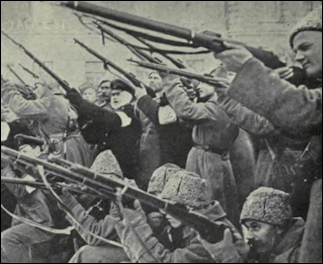 As a consequence of Russia's involvement in World War I, the tsarist government was reeling under food shortages, near-famine conditions, military mutinees, palace intriguea, popular discontent and a collapsed economy.
As a consequence of Russia's involvement in World War I, the tsarist government was reeling under food shortages, near-famine conditions, military mutinees, palace intriguea, popular discontent and a collapsed economy.
The chain of events that led to the end of Nicholas II and creation of a Russian Communist government were: 1) Rasputin's murder in December 1916; 2) strikes by workers and soldiers in February 1917; 3) the abdication of Nicholas II in March 1917; 4) the overthrow of the provisional government made up of Duma members in a Bolshevik coup d'etát in November 1917.
The 1917 Revolution began in February (March by Western calendars) with strikes by metal workers in Petrograd (St. Petersburg) which attracted tens of thousands of people who milled around the streets. The army refused to put down the strike and soldiers joined rebellious workers in taking control of the city. There were also food riots and mass army desertions.
The Duma ignored demands to disband. Socialist members of the Duma formed a council called the Petrograd Soviet of Workers and Soldiers that included of workers and soldiers. This council joined with Duma to cerate a revolutionary government and demand the abdication of Nicholas.
Weak and discouraged, Nicholas II was blocked from re-entering Petrograd by his own troops. He quietly abdicated on March 2, 1917. Power was handed over to a provisional government in the Duma that announced elections in November. After the tsar abdicated real power in Russia was in the hands of thousands of local councils (the Soviets) that had sprung up all over the country. The Bolsheviks used a propaganda campaign to gain control of many of them.
After a series of demonstrations in July 1917, known as the "July Days" the provisional government in Russia came under the leadership of Aleksandr Kerensky, the son of the principal at Lenin's high school. The Kerensky government took power with a minimum of bloodshed and initially was welcomed with high hopes by ordinary Russians. Kerensky tried to continue the war against Germany while he attempted to implement political reforms such as freeing political prisoners, ending discrimination, allowing free speech and a free press and democratizing the government. The Kerensky government lasted for only four months after Tsar Nicholas II’s abdication.
Rise of the Bolsheviks
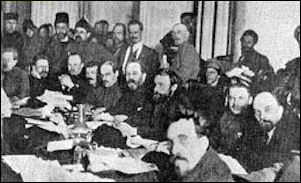
Bolshevik meeting In September 1917, the Russian military sent a cavalry to Petrograd in an effort to crush the Soviets. Kerensky turned to the extreme left for help and even courted the Bolsheviks. The counter-revolution was defeated and the influence of the Bolsheviks rose.
While Russians appreciated Kerensky's reforms they were more concerned with extracting themselves from the war and getting enough to eat. For a quicker response to these concerns they turned to the Bolsheviks and Lenin.
The Bolsheviks took advantage of their sudden popularity and seized control of the Petrograd Soviet, chaired by Leon Trotsky, a Menshevik-turned- Bolshevik. The Petrograd Soviet was the most powerful council and it had a strong influence on the other Soviets scattered across Russia. Lenin decided the time had come to overthrow the government. The Mensheviks were a faction of the Russian revolutionary movement that emerged in 1904 after a dispute between Vladimir Lenin and revolutionary leader Julius Martov.
Lenin Before the October Revolution
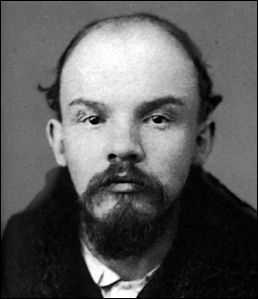
Lenin, 1895 mugshot On April 16, 1917, about a month after the abdication of Nicholas II, Lenin slipped back into Russia across the Swedish border on a sealed railcar with German help. He and Trotsky and 30 other revolutionaries were brought into the country with German help under the understanding that once Lenin took power he would pull Russia out of World War I.
The revolutionaries were greeted by huge crowds carrying red and gold banners and torches. Addressing a crowd in the streets from an armored car Lenin shouted, "Long live the worldwide Socialist revolution!" Some say that the turning point of the whole revolution occured when a unit or armored-car troops, regarded as the most powerful in the city met at the Mikhailovsky Riding School. Their support was key to power. The American journalist John Reed wrote: “Inside, only a single arc lamp burned dimly, high up near the roof of an enormous hall...Around dimly squatted the monstrous shapes of the armored cars. One stood alone in the center of the place under the light, and around it were gathered some two thousand dun-colored soldiers, almost lost in the immensity of the building. There the Bolshevik leader N.V. Krylenk stood on an armored car and persuaded the armored car troops to side with the Bolsheviks.
In July, 1917 Lenin was branded as a radical and a German sympathizer by Kerensky's provincial government. Lenin was forced to go into hiding once again. Before escaping to Finland he hid in the loft of a barn in a hollowed-out haystack. On October 22, 1917, Lenin returned secretly to Russia. He entered the headquarters of the Bolsheviks for his first speech with his beard shaved off, wearing a wig and disguised as a man with a toothache. No one recognized him and he was reportedly even offered a sausage roll by the leader of the Mensheviks.
October Revolution and Storming of the Winter Palace om November 7, 1917

October Revolution Patrol The October Revolution refers to the takeover of Russian government by the Lenin-led Bolsheviks in 1917. The event occurred in October on the Russian calendar, and occurred in November in the Western calendar. Russian often refer to the event as Red October. The key moment of the Bolshevik Revolution came when Lenin ordered the Bolsheviks to storm the Winter Palace where the Kerensky government was holed up on November 7 (October 25 on the old Russian calendar), a day that was marked with a holiday during the Soviet era known as Revolution Day. [Source: Dusko Doder, National Geographic, October 1992 [♦]
On November 6, Lenin took a firm grip of the revolution and ordered the Bolsheviks to seize the railway stations, state banks, power stations and telephone exchanges at daybreak on November 7th, the day when an the second All-Russian Congress of Soviets was scheduled to be held. By the evening the Bolsheviks had seized power by taking key buildings in Petrograd, including the Winter Palace, where the provisional government was based. Kerensky escaped (he die din the U.S. in 1970) but his cabinet was arrested. When the congress met that night Lenin was declared premier.
According to Karl Rianni, a 99 year old Estonian who was there, "Lenin had a general plan. The Baltic Fleet sailors and the Petrograd workers were to play the key role in seizing control of the city. We had to take the key government buildings, all the bridges, the telegraph and telephone communications...A tall iron fence surrounded the palace. One of the gates had not been locked. We saw this and opened the gate wide. Like a wave of black lava we moved into the palace, followed by workers and soldiers. There was no resistance, none at all. They surrendered their weapons. We arrested the members of the provisional government."♦
John Reed's Account of the Storming of the Winter Palace
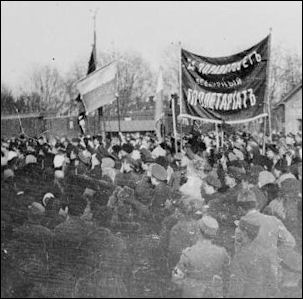
Bolshevik rally John Reed, who was played by Warren Beatty in the film Reds wrote: "Like a black river, filling all the street, without song or cheer we poured through the Red Arch, where the man just ahead of me said in a low voice, 'Look out, comrades! Don't trust them; They will fire surely!" In the open were began to run, stooping low and bunching together, and jammed up suddenly behind the pedestal of Alexander Column..."
"After a few minutes huddling together, some hundreds of men, the army seemed reassured and without any orders suddenly began again to flow forward. By this time, in the light streamed out of all the Winter Palace windows, I could see that the first two or three hundred men were Red Guards, with only a few scattered soldiers. Over the barricades of firewood we clambered, and leaping down inside gave a triumphant shout as we stumbled on a heap of rifles thrown down by the yunkers who stood there. On both sides of the main gateway the door stood wide open, light streamed out, and from the huge pile came not the slightest sound."
"Carried along by the eager wave of men we were swept into the right-hand entrance, opening into a rear bare vaulted room, the cellar of the east wing, from which issued a maze of corridors and staircases. A number of huge packing cases stood about, and upon these the Red Guards and soldiers fell furiously, battering them openly with the butts of the rifles, and pulling out carpets, curtains, linen, porcelain, plates, glassware."
"One man went strutting around with a bronze clock perched on his shoulder; another found a plume of ostrich feathers, which he stuck in his hat. The looting was just beginning when somebody cried, "Comrades! Don't take anything. This is the property of the people!' Immediately twenty voices were crying, 'Stop! Put everything back! Don't take anything! Property of the people!' Many hand dragged the spoilers down."
"In the west wing...there order was also being established. 'Clear the palace!' bawled a red Guard, sticking his head out through inner door. 'Come, comrades, let show that we're not thieves and bandits. Everybody out of the Palace except the Commissars, until we get sentries posted'...Shout of 'All out! All out!' were heard from far and near."
"As each man appeared he was seized by the self-appointed committee, who went through his pockets and looked under his coat. Everything that was clearly not his property was taken....The most amazing assortment of objects were thus confiscated: statuettes, bottles of ink, bedspreads worked the Imperial monogram, candles, a small old painting, desk blotters gold-handled swords, cakes of soap, clothes of every description, blankets."
John Reed's Account of the Takeover of the Winter Palace

Bolshevik bombs Yunkers came out in bunches of three or four. The committee seized upon them with an excess of zeal, accompanying the search with remarks like, 'Ah, Provocateurs! Kornilovists! Counter-revolutionaries! Murders of the People!' But there was no violence done, although the yunkers were terrified...they were allowed to go free."
"In the meanwhile unrebuked we walked int the Palace. There was still a great deal of coming and going...We penetrated at length to the gold and malachite chamber with crimson brocade hangings where the Ministers had been in session all that day and night, and where the shveitzari had betrayed them to Red Guards.
"The long table covered with green baize was just as they had left it, under arrest. Before each empty seat was a pen, ink and paper; the papers were scribbled over the beginnings of plans of action, rough drafts of proclamations and manifestos. Most of these were scratched out, as their futility became evident, and the rest of the sheet covered with absent-minded geometrical designs, as writer sat despondently listening while Minister after Minister proposed chimerical schemes. I took one f these scribbled pages, in the hand writing of Konovalo, which read, 'The Provisional Government appeals to all classes to support the Provisional Government."
Takeover of Russia by the Bolsheviks
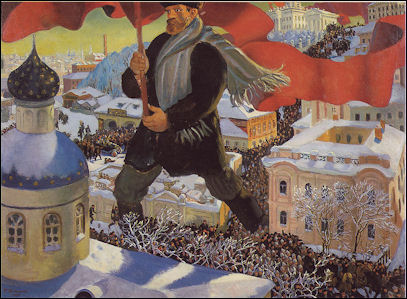
At the All-Russian Congress meeting in Petrograd on November 7 Soviets across the country were made the ruling councils of Russia and they in turn were controlled by a "parliament" called the Soviet Central Executive Committee.
Local soviets were able seize power of the government relatively easily. Some fighting occurred in Moscow and other cities but within a week the Bolsheviks were firmly in control. Scheduled elections were held in November. More than half the male population voted, with Kerensky's rural Socialist party taking 55 percent of vote and Bolsheviks taking 25 percent. When the assembly met in January 1918 it was disbanded on its first day by the Bolsheviks.
A Council of People's Commissars, headed by Lenin, became the government. The new Bolshevik government was not recognized by Russia's European Allies. In the first days of the regime, the Constituent Assembly was closed as the leaders of rival parties such as the Kadets and the Left Socialist Revolutionaries were murdered.
How was Lenin able to grab power from the Kerensky's provisional government with relative ease and little bloodshed even though the Bolsheviks had only 10,000 active members? Lenin was a brilliant tactician who was able blend Marxist ideology, insurrection tactics and propaganda. The Bolshevik plea for "Peace to the army, land to the peasants, ownership of the factories to the workers," was much better received than Kerensky's plan to keep Russia in World War I. The Russian army, shattered by defeats in East Prussia, Poland and the Ukraine, offered little resistance. It collapsed altogether in 1918. The Kerensky government and the elected government didn't have the military might necessary to back them up.
Mao Zedong
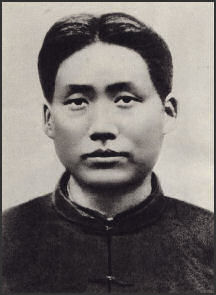
Mao in Wuhan in 1927 Mao Zedong (1893-1976) was another major figure of the 20th century. "If power is measured by impact on people's lives," Emily MacFarquhar wrote in U.S. News and World Report, "Mao Zedong was the most powerful man in history. The wars and revolution and political campaigns he led left no one untouched in a country of hundreds of millions. His quixotic crusades may have killed more people than the mass exterminations of Hitler and Stalin combined. In his lifetime, he was worshiped as a god and his books sold better than the Bible. After his death, he was demystified and dethroned. Today, he is the object of a pop culture cult."
On the positive side, Mao was a brilliant political tactician, a clever, charismatic and persuasive leader, a survivor who time and again outmaneuvered his rivals, and a prolific writer who described himself as an “indefatigable teacher.” He showed his toughness and patience during the Long March and again in his resistance against the Japanese. On the negative side he was obsessed with power and eliminating his enemies and many of his ideas such as the Great Leap Forward were half baked.
As a young man Mao wrote passionate articles about the individual’s freedom to love that old China had denied and new China would guarantee. But when Mao took over China, securing the wealth and power of the Chinese nation took preference over the individual. [Source: Ross Terrill, The China Beat, February 26, 2010]
Mao's earliest surviving essay, written when he was 19, championed the pragmatic but ruthless policies of Shang Yang, a 4th century B.C. administrator who established a set of laws designed "to punish the wicked and rebellious, in order to preserve the rights of the people." Mao concluded, "At the beginning of anything out of the ordinary, the mass of the people always dislike it."
In 1927 and 1930, Mao produced studies on rural conditions in Hunan and Jiangxi provinces that were key to the development of his theories on peasant mobilization and class struggle. The studies examined things like the practice of selling children to pay off debts, money made by local temples and disparities between rich and poor.
In his 1927 treatise On Going Too Far Mao wrote: "To right a wrong it is necessary to exceed proper limits, and the wrong cannot be righted without proper limits being exceeded...To put it bluntly it is necessary to bring about a brief reign of terror." It is a Chinese tradition that senior mandarins make their views known by praise or condemnation of a piece of literature; it was a favorite tactic of Mao's.
Maoism and Maoist Ideas About Revolution
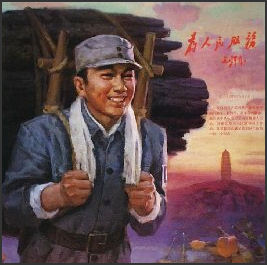 Maoism is a variant of Marxism, derived from the literature of Mao Zedong and is widely applied as the political and military guiding ideology in the Communist Party of China (CPC). Maoism is basically Marxism--which mostly addressed urban revolution--adapted to agrarian societies, with peasant farmers being the discriminated underclass rather than factory workers. Unlike the Russian Communists, who initially ignored rural peasants and believed that revolution was spread through the cities by workers in short dramatic bursts of activity, Mao believed that engaging Chinese peasants in a long war was the key to the success of his revolution.
Maoism is a variant of Marxism, derived from the literature of Mao Zedong and is widely applied as the political and military guiding ideology in the Communist Party of China (CPC). Maoism is basically Marxism--which mostly addressed urban revolution--adapted to agrarian societies, with peasant farmers being the discriminated underclass rather than factory workers. Unlike the Russian Communists, who initially ignored rural peasants and believed that revolution was spread through the cities by workers in short dramatic bursts of activity, Mao believed that engaging Chinese peasants in a long war was the key to the success of his revolution.
Mao liked to turn things around so the sacred became profane and low became the high. He won the support of peasants with his radical proposal to seize land from the landowners and redistribute it among the peasants. He believed the most effective military strategy would be to patiently infiltrate the countryside with guerrillas and fight a protracted war of attrition that would eventually frustrate and ultimately exhaust the Communist's more powerful enemy---the Kuomintang and Chiang Kai-shek.
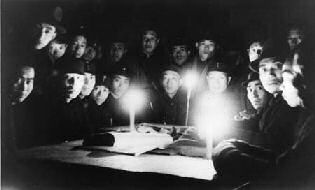
Night meeting in 1920s In a 1929 memorandum Mao wrote: "The tactics we have derived from the struggle of the past three years are indeed different from any other tactics, ancient or modern, Chinese of foreign. With our tactics, the masses can be aroused for struggle on an ever-broadening scale, and no enemy, however powerful, can cope with us.”
Based on Karl Marx's view that the "the proletariat cannot liberate itself without liberating the whole of humankind", Mao's internationalism holds that Chinese people must support anti-oppression movements worldwide. Mao used to organize massive demonstrations at Tiananmen Square and issued statements to show Chinese people's support for "revolutionary" movements across the world.
Mao promoted world revolution. He urged oppressed people everywhere to “dare to fight, defy difficulties and advance wave upon wave.” The Khmer Rouge and the Shining Path in Peru were Maoist movements. The Viet Cong effectively utilized Maoist ideas in their fight against the American forces in the Vietnam War. There are still Maoist rebels active in Nepal and India.
Mao and Guerilla Tactics
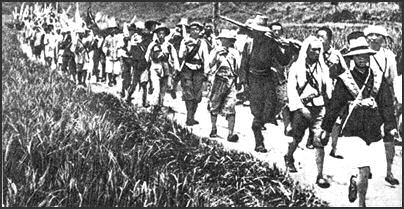
The Long March Mao was a great spokesman for guerilla tactics. “The guerilla,” he wrote, “must move among people as a fish swims in the sea.” He said guerilla tactics are what “a nation inferior in arms and military equipment may employ against a more powerful transgressor.” On guerilla tactics themselves, he wrote:. “They consist mainly of the following points: Divide our forces to arouse the masses, concentrate our forces to deal with the enemy...Arouse the largest number of the masses in the shortest possible time."
The Red Army had a great deal of success by following tactics outlined in the following slogans: "When the enemy advances, we retreat. When the enemy halts and encamps, we harass him. When the enemy seeks to avoid battle, we attack. Whenever the enemy retreats, we pursue." The highly mobile Red Army attacked quickly with a sudden concentration of force and then quickly dispersed after the attack was over.
Large battles against forces that outnumbered them were avoided at all costs. Communists in unfriendly territory operated underground and in cells and through united front operations. When a military operation was taken it aimed to follow classic Maoist insurgency theory: overrun police outpost and remote military bases; let the state overreact with human rights abuses; capitalize on the resulting public anger over the abuses to gain support and win new recruits.
Mao was not a great military tactician but he was able to surround himself with talented military minds. He also realized that one of the greatest underutilized military assets was women. Jiang Jee was young female revolutionary who was killed in fighting the Nationalists and made into a martyr.
Mao Organizes a Guerilla Army Mao Takes Over the Communist Party
 In 1927, Mao led a group of Hunan peasants in the mountains of Jiangxi Province, where they created a Soviet-style government and started building a guerilla force. By 1930 the Jiangxi Soviet controlled several million people and the Red Army numbered 200,000. In the meantime the Kuomintang---the group headed Chiang Kai-shek that weakly led parts of China at the time---began a campaign to exterminate the Communists.
In 1927, Mao led a group of Hunan peasants in the mountains of Jiangxi Province, where they created a Soviet-style government and started building a guerilla force. By 1930 the Jiangxi Soviet controlled several million people and the Red Army numbered 200,000. In the meantime the Kuomintang---the group headed Chiang Kai-shek that weakly led parts of China at the time---began a campaign to exterminate the Communists.
In the 1930s Mao traveled to villages, where peasants grew rice for wealthy landlords and ate nothing but potatoes themselves, and called on them to take up arms and take the land for themselves. At that time Mao was described as tall, rangy and good looking. He chain smoked and looked people directly in the eye, exuded coincidence and persuaded peasants with his logic and charisma.
Mao received trunks full of Mexican silver dollars and instructions from Soviet leader Joseph Stalin, without which many historians have argued the Chinese Maoist Revolution would not have been possible. Stalin is said to have played a major role in Mao’s rise. Betrayal and intra party rivalry led to frequent purges. Blunders by Mao led to the unnecessary loss of thousands in hopeless battles.
Against the advise of Mao and his followers, Li Lisan, leader of the Communist Party at that time, committed 180,000 men to a series of great battles in the early 1930s against the Kuomintang, who was being advised by Prussian officers who taught the Kuomintang how to build forts and fortify supply lines to entrap their enemy. The Communists lost the battles and their movement almost collapsed.
Mao took control of the Communist Party after he refused Li's orders to lead a major offensive against Changsa. Shortly after the Long March began, Mao was elected chairman of the Communist Party at a politburo conference in Kweichow. With Mao at the helm, the Communists stuck to guerilla warfare and avoided large battles. These tactics, patience and help from world events like World War II help Mao and his followers prevail and take over China.
French Resistance in World War II
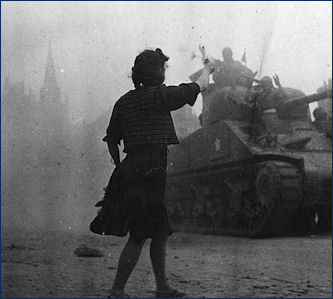
In World War II the French Resistance was an underground movement that carried out guerilla-style attacks against the Nazis in occupied France. The first successful operation of the French Resistance reportedly was the blowing up of an electrical plant in Bordeaux harbor used to power German submarines in May, 1941 by four French commandos led by Joël Le Tac. Le Tac was arrested soon after that. He was said to have been deported with orders to be "worked to death or shot" but he survived seven concentration camps and was liberated from Bergen-Belsen in April 1945.
In the early stages of the war the French resistance was very small and being a member was very dangerous. Spies were everywhere and the Germans had no qualms about ruthlessly cracking down on people perceived as traitors. One particularly notorious Nazi spy, Paul Cole, a former British Army sergeant who migrated to France, turned over more than 200 men and women to the Gestapo. The French police often enthusiastically helped the Nazis track down members of the resistance to further their own careers.
After the war it sometimes seemed that every Frenchman claimed to be a member of the Resistance but in reality only about 300,000 were recognized as being involved. Future French President François Mitterrand was a member. Charles de Gaulle directed some Resistance activities from overseas. Both Churchill and Roosevelt had little respect for de Gaulle and it was only though the efforts of Churchill's Foreign Secretary Anthony Eden that the Allies put their support behind de Gaulle.
Johnny Hopper, Heroic Unofficial French Resistance Member Who Shot How Own Wife
One of the most dashing informal members of the French Resistance was John Hopper, an Englishman from East Anglia who was married to a French woman. Acting as a lone wolf in Normandy and Paris, Hopper derailed trains, robbed banks and department stores, blew up ammunition and oil depots and killed a German colonel to obtain his uniform for another mission. [Source: Robert Wernick, Smithsonian magazine]
Hopper once borrowed a waiters jacket and shot an SS officer in the head after delivering a nightcap of cognac. He escaped with the help of two comrades who lowered a rope from the roof of the building where the killing took place and hauled both Hopper and the dead SS officer out of window.
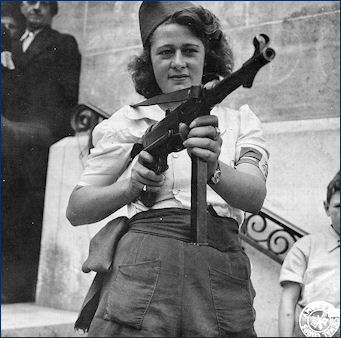
Nicole, a French Partisan,
captured and killed by Nazis
at age 25 Explaining how he was such an effective killer Hopper old Smithsonian, "I was quicker.” On one of his early victims he said, “The moment he got that gun in his hand I noticed a kind of tightening about his jaw. I saw that tightening many times afterwards, saw it in some of the best killers the Gestapo put on my trail. What it means...is that at the moment when their lives are on the line, no matter how professional they are there is a moment when they can't help thinking of what might happen."
Describing an ambush of himself and his wife at a bar, Hopper said, there was shooting everywhere. "I ducked back through a door next to our table, to take stock and get a fresh gun unstrapped from my leg. Germans must have assumed it was a rear door to the alley. I had hit them all more or less badly, and when I kicked my door open they all went running out the front door for help. All the customers and the bartender were still on the floor. I looked around to the table where we had been sitting, and there was my wife with her head on the table." In a split second, Hopper judged she had been fatally wounded (blood poured from her mouth) but she might live long enough to talk so he shot her through the right eye.
In August 1942, Hoper was caught by French police in a routine identity check. He was beaten to a pulp and turned over to the Germans, who placed him in solitary confinement at a French prison with chains around his legs and arms. Later he was transferred to the Mauthausen death camp in Austria. He survived the war.
Czech Resistance and British Special Operations
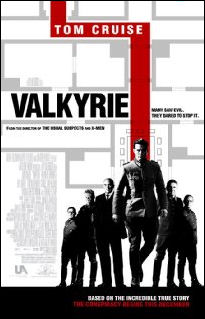
Tom Cruise movie about
Hitler assassination attempt In May 1942, Czech resistance fighters killed Reinhard Heydrich, the infamous German "protector" of Bohemia and Moravia, who was also known as the "hangman of Europe" for his brutal treatment of civilians in Czechoslovakia and elsewhere in Europe. In a speech after the killing Hitler screamed that if the Czech's couldn't "co-exist peacefully" with the Nazis they would be resettled in the Arctic. A few days later the small Czech town of Lidice, located near the site of Heydrich’s assassination, was burned to the ground and all the adults in it where lined up and shot and the children were shipped to German orphanages and given German names.
Describing the daring kidnappings of the commanding German general in Crete, British special operations agent Stanley Moss wrote: "I held up a traffic signal and we stood in the center of the junction...The car stopped...Everything happened so quickly. There was a rush from all sides. We tore open our respective doors, and our torches illuminated the interior of the car---the bewildered face of the General, the chauffeur's terrified eyes, the rear seats empty.
"With his right hand the chauffeur was reaching for his automatic, so I hit him across the head with a cosh. He flee forward, and George, who had come up behind me, heaved him out of the driving-seat and dumped him on the road. I jumped in behind the steering wheel, and at these same moments saw Pady and Manoli dragging the General out of the opposite door. The old man was struggling with fury, lashing out with his arms and legs. He obviously thought he was going to be killed, and started shouting every curse under the sun at the top of his voice." The General was tied up and one of the agents sat in the back with his hat on.”
"The engine of the car was still ticking over, the hand-brake was on, everything was perfect." They took off. “During the course of our evening's drive we passed 22 control posts." At most of them they slowed enough so the guards at the roadblocks could see the General's pennants on the wings of the car. "On five occasion we came to roadblocks---raised one-bar barriers---which brought us to a standstill. Each time however, the General's pennants did the trick like magic, and the sentries would either give us a smart salute or present arms as the gate was lifted, and we passed through."
German Resistance
There was a small resistance movement in Germany. According to Anton Gill, author of An Honorable Defeat, the German Resistance included "coup plotters, leftists, dissidents in churches, the White Rose group, the Kreisau circle, anti-authority youth gangs like the Edelweiss Pirates. Major resistance leaders included Protestant theologian Dietrich Bonhoeffer, military intelligence official Hans Oster and leader Helmuth James von Motke.
One of the most well-known German resistance groups was the White Rose movement (a student organization that advocated passive resistance against the Nazis). On February 19, 1943, two of its members, Hans Scholl and his sister Sophie, both students at Munich university, were arrested for distributing anti-Nazi pamphlet on campus. After being convicted of crimes against the state, they were beheaded. One Hans, yelled "Long live liberty!" before the blade of the guillotine dropped.
During the war German protesters prevented Nazis from taking the crosses off Bavarian churches. In 1943, "Aryan" women protested the deportation of their Jewish husbands to concentration camps.
Hitler Assassination Attempts
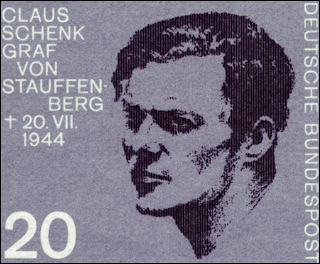
German Stauffenberg
commemoration stamp Hitler was aware that many wanted to kill him. By one count 42 attempts were made to assassinate him. To foil attempts on his life , he spent much of his time hidden in remote fortress headquarters; only a few trusted leaders knew his travel plans, which were always altered at the last minute; and he always arrived early and departed so he was "rarely where people expected him to be." An excellent marksman, he carried a revolver and frequently wore a bullet proof vest and cap lined with a 3½ pound steel plate. To foil plans hatched within the military, he often shifted the commands of his officer so they couldn't organize a conspiracy against him. [Source: People's Almanac]
A bomb placed on Hitler's plane in 1943 failed to detonate. One conspirator brought a bomb in a suitcase to a high level meeting but Hitler failed to appear. An assassination at an art gallery failed when Hitler left before the suicide bomber had an opportunity to approach him.
A 24-year old captain was recruited to carry a bomb on his body and blow up both himself and Hitler while showing the fuhrer a new line of winter uniforms. The plot was called off, ironically, after an Allied bomber destroyed the truck carrying the uniforms. The captain was later sent to the Russian front, where he lost a leg. [Source: William Ellis, National Geographic, September 1991]
British intelligence reportedly hatched plans to assassinate Hitler in 1944 by putting anthrax into his tea, planting a bomb under his train, using a sharp-shooter to pick him off at Berchtesgarden, where "he always walks alone" to a tea house "strolling at a fairly leisurely manner." The plans were reportedly abandoned because the war was nearly over when they were discussed and there were fears killing him might do more harm than good by making a martyr out him.
Stauffenberg’s Hitler Assassination Attempt
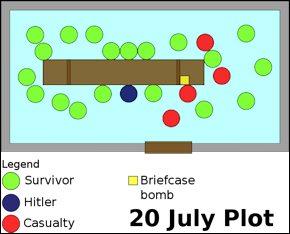
July 20 Conference
Room Floorplan There was 17 known German assassinations attempts against Hitler. The film Valkrie, starring Tom Cruise, is based the 1944 plan to kill Hitler called OPERATION VALKYRIE (Unternehmen Walküre). Colonel Claus Schenk Graf Von Stauffenberg was responsible for carrying out both the assassination attempt and the Valkyrie Operations ( a coup attempt based on a contingency plan on what do if Hitler died) did not succeed.
On July 20, 1944, Col. Claus von Stauffenberg, the 36-year-old chief of staff to the commander of the reserve army, showed up at a meeting at the "Wolf Lair," Hitler's secret headquarters in Rastenburg in what is now Poland. Before attending a meeting where Hitler was present, the colonel slipped into a bathroom to activate a 10 minute fuse connected to two pounds of British explosives.
Stauffenburg has despised Hitler since 1936 and once called him a "buffoon" and "enemy of the world." After stepping out of the bathroom Stauffenberg went to the meeting in a large conference room where Hitler and 23 other important Nazi leaders was seated by behind a huge oak table (the meeting was originally scheduled to take place a smaller, more enclosed room where the bomb would have been more lethal). The colonel sat down at the table about six feet to the right of fuhrer, laid down the briefcase and then left after saying something about a phone call.
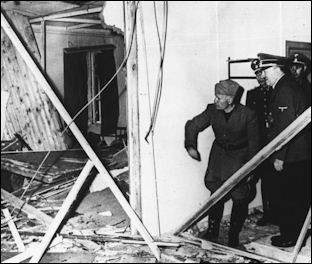
Hitler surveying the damage General Adolf Heusinger was giving a report and Colonel Heinz Barandt moved the briefcase underneath the table, apparently so he could see better. The bomb exploded just as Hitler leaned across the table to look at a map. The ceiling shattered into pieces and bodies were flung against the wall. Four people were killed and several people were hurt badly, but Hitler escaped only with burns and damaged eardrums, apparently protected by the oak table. Despite suffering from shock, he recovered enough to meet Mussolini two hours later.
Stauffenberg was a 100 meters away when the bomb exploded and he managed to get out of the compound and onto a plane. The assassination attempt was part of coup attempt put together by mid-rank aristocratic Nazi officers. The leaders of the coup announced that Hitler was dead and arrests were made by the coup conspirators and counter arrests were made by loyal Nazis. Five hours after the bomb went off Goebbels broadcast that Hitler was alive. Historians believe that Hitler could have been more easily assassinated if the person doing the killing had been willing to die. Von Staufenberg left before the bomb exploded and thought he had succeeded in killing Hitler.
Hitler took terrible revenge. SS officers shot their way into the war offices where the coup leaders were holed up and arrested the coup leaders. Justice was meted almost immediately, and some leaders were given the choice of suicide or the firing squad, but most of them were just shot. According to one source 7,000 arrests were made and 2,000 people were executed. Among his victims were Col. Ludwig Beck and Carl Goereler, former chief mayor of Leipzig. Count Staffenberg was found guilty of treason and shot by a firing squad. His last words were, "Long live sacred Germany!" Some conspirators were hung from meat hooks. Staffenberg’s wife and young children survived the war.
Image Sources: Wikimedia Commons, except Night meeting by Agnes Smedly, University of Arizona
Text Sources: New York Times, Washington Post, Los Angeles Times, Times of London, The Guardian, National Geographic, The New Yorker, Time, Newsweek, Reuters, AP, AFP, Wall Street Journal, The Atlantic Monthly, The Economist, Global Viewpoint (Christian Science Monitor), Foreign Policy, Wikipedia, BBC, CNN, NBC News, Fox News and various books and other publications.
Last updated July 2012
